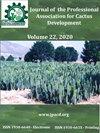无花果机会菌厌氧共消化的研究轧机。牛粪加枝线虫:不同品种对生化甲烷势的影响
IF 0.4
4区 农林科学
Q4 HORTICULTURE
Journal of the Professional Association for Cactus Development
Pub Date : 2022-03-23
DOI:10.56890/jpacd.v24i.453
引用次数: 0
摘要
无花果(Opuntia ficus-indica)由于其可持续性生产,最近在农业能源领域引起了人们的极大兴趣。本研究的目的是比较不同品种野菜与牛粪共消化的生化甲烷势。为此,对两种不同品种(牛粪比例分别为75:25和82:18)和3个不同品种(Atlixco、Copena V1和Milpa Alta)进行了评价。结果表明:生化甲烷势(mL CH4 g-1 VSfed)较高的处理为Milpa Alta 75:25(71.4)、Copena V1 75:25(66.5)、Milpa Alta 82:18(64.6)和Copena V1 82:18(59.0),差异无统计学意义(P<0.05),而Atlixco处理(75:25和82:18)的生化甲烷势最低(分别为52.8和41.5)。结果表明,牛粪比例和共消化系统中使用的nopal品种可能影响其生化甲烷势。本文章由计算机程序翻译,如有差异,请以英文原文为准。
Anaerobic co-digestion of Opuntia ficus-indica (L.) Mill. cladode with cow manure: Effect of different cultivars on biochemical methane potential
Nopal (Opuntia ficus-indica (L.) Mill.) cladode has garnered great interest recently in the area of agro-energy as emerging biomass due to its sustainable production. The objective of this study was to compare the biochemical methane potential of different nopal cultivars in co-digestion with cow manure. For this purpose, two different nopal cladodes: cow manure proportions (75:25 and 82:18) and three different cultivars (Atlixco, Copena V1, and Milpa Alta) were evaluated. The results indicated that the treatments with higher biochemical methane potential (mL CH4 g-1 VSfed) were Milpa Alta 75:25 (71.4), Copena V1 75:25 (66.5), Milpa Alta 82:18 (64.6), and Copena V1 82:18 (59.0), which showed no statistical difference (P>0.05) between them, whereas the Atlixco treatments (75:25 and 82:18) had the lowest (P<0.05) values (52.8 and 41.5, respectively). The results suggest that the cow manure proportion and nopal cultivar used in a co-digestion system may influence its biochemical methane potential.
求助全文
通过发布文献求助,成功后即可免费获取论文全文。
去求助
来源期刊

Journal of the Professional Association for Cactus Development
Agricultural and Biological Sciences-Plant Science
CiteScore
1.10
自引率
33.30%
发文量
10
期刊介绍:
The editors of the Journal of the Professional Association for Cactus Development, are very excited to be a part of the excellent editorial committee and to work together to create the synergism between scientists, growers, legislators, and business people so vital to the development of this industry to serve the people of arid lands.
 求助内容:
求助内容: 应助结果提醒方式:
应助结果提醒方式:


